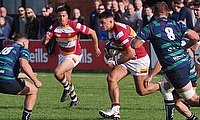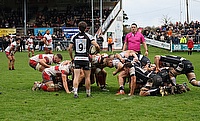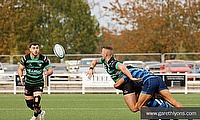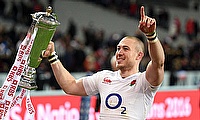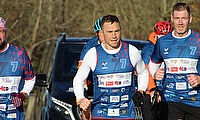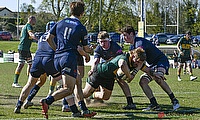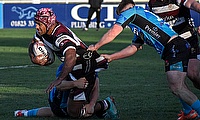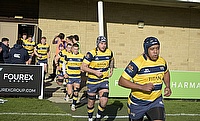National League 2 North - Club Watch - Caldy RFC
The TalkingRugbyUnion team will be out and about this week following teams in National 2. Last weekend we made our way east to follow the progress of Hull Ionians.
In a game that pitted 2nd versus 3rd, we witnessed exhilarating running rugby from Sedgley Tigers in the first half and composed pressure rugby from Ionians in the second half. This week we travel to watch Chester.
A set of interesting results across National 2 in both the North and the South. In National 2N, it was Chester who claimed the accolades securing victory against high flying Ampthill & District. In the South, Canterbury ended a four-match losing streak against Shelford.
National 2 North - last week's results
Chester 15-13 Ampthill & District
Harrogate 59-14 Stockport
Huddersfield 26-11 Hull
Hull Ionians 28-19 Sedgley Park
Leicester Lions 33-19 Caldy
Luctonians 31-22 Broadstreet
Preston Grasshoppers 19-20 Birmingham & Solihull
Stourbridge 23-37 Otley
National 2 South - last week's results
Cambridge 14-28 Dorking
Canterbury 37-22 Shelford
Clifton 7-20 Henley Hawks
Cornish All Blacks 22-26 Chinnor
Old Elthamians 38-29 Dings Crusaders
Southend 50-13 Lydney
Taunton Titans 24-17 Redruth
Worthing Raiders 24-22 Bishops Stortford
In preparation for this weekend’s fixtures we reflect on Caldy Rugby Club. We have published photographs from last year's final game of the season. Images of rugby people enjoying this lovely rugby ground on the Wirral.
The club’s history starts in 1924 when some Old Boys of Calday School, with the encouragement of the then Headmaster, R. T. B. Glasspool, decided that they must carry on playing rugby together so the 'Old Caldeians' R.F.C. came into being at a meeting held at the Blenheim Café in West Kirby.
They started playing in a farm field at Caldy crossroads and changing in the farm buildings at Croxton Farm, bathing facilities were somewhat primitive - they used a tin bath which was filled from a tap in the farmyard.
The Wirral is across the river Mersey from Liverpool; that proximity must be the reason that the club had such a strong period in the sixties both musically and on the field.
The first Sevens dance was held at Paton Field featuring Humphrey Lyttelton and it was a great success making a profit of £572. This relieved the club of all its financial burdens and a new development was planned to move the first XV pitch in front of the clubhouse.
As the original land sloped gently down to the cricket square it would require a substantial amount of land to be moved so it would have to be done by a professional company. The lowest tender came from Floods for £5953. This also involved using the surplus soil to raise the middle pitch and extend it towards the road.
The club needed to raise a substantial sum of money but with the continued success of the sevens dances the club were able to proceed with the plan. To keep the cost down the club members dug up the posts round the old First XV pitch and replaced them around the new pitch and down the drive to the road.
They also dug the steps up the bank to the clubhouse. The club, with support of the Parkinson family, purchased three sets of metal posts to replace the old wooden ones.
The quality of the musicians supporting the Sevens Dances was impressive:
1961 - Humphrey Lyttelton
1962 - Chris Barber
1963 - Kenny Ball
1964 - Acker Bilk
1965 - Humphrey Lyttelton
At the 1963 dance the club had booked a group called The Beatles on the undercard but they asked to be released as their record had just reached number one. The Four Pennies replaced them.
At the 1964 dance the attendance topped 4,500, the main tent was over 100yds long and the bar tent 80yds. Then in 1971 the club became known as Caldy.
Twenty years later and the club were continuing their far-sighted approach to rugby and rugby sevens.
"The Sevens Committee added an international Sevens competition to the already successful Merseyside Sevens Competition," the club’s website reports.
"It proved a great success attracting many overseas sides, Fiji, Western Samoa, Russia, Latvia, Malaysia, together with representative sides from Canada, South Africa, France and Scotland. A number of top English sides also took part, including Harlequins Wasps, Orrell, Bristol and many more.
"One notable young player for the Wasps side was Lawrence Dallaglio. However with the advent of professional Rugby this event had to be dropped, as we were unable to compete with the bigger sponsored events that were set up in competition.
"The event is still held in esteem as one of the best-run events on the calendar. And its hospitality was legendary."
Today the club play in National 2; on our visit last season we found the club most welcoming and friendly. Good luck to all those involved.
There are quite excellent teams and players in National 2 and for more details of what occurred last week and the prospects for this week, take a look at our friend Sedge Tiger’s article by clicking here.

